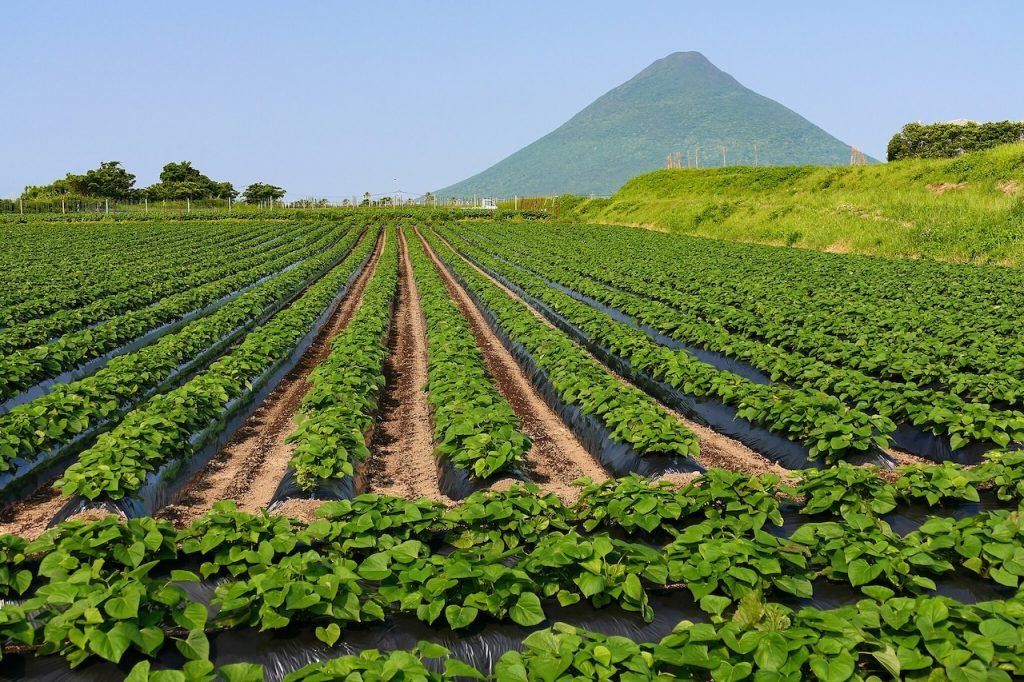
Kyushu, Japan’s third-largest island, is renowned for its diverse agricultural production. The region boasts unique crops such as sweet potatoes, strawberries, and high-quality beef like Kagoshima wagyu. Satellite data and remote sensing technologies are playing a crucial role in enhancing the sustainability, productivity, and climate resilience of Kyushu’s specialty agriculture. This article explores how farmers in Kyushu are integrating satellite technology to optimize production practices for their unique crops and improve overall agricultural efficiency.
Boosting Sweet Potato Production in Kagoshima with Remote Sensing
Kagoshima Prefecture is a major producer of sweet potatoes, particularly the satsumaimo variety, which is prized for its sweetness and texture. Sweet potatoes are a hardy crop, but they require precise irrigation management and monitoring of soil conditions to maintain high yields.
Satellite imagery provides essential insights into soil moisture levels, vegetation health, and temperature variations across large plots of land. By analyzing vegetation indices such as NDVI, farmers can assess the overall health of the crops and detect areas that need additional irrigation or nutrient inputs. This data-driven approach helps Kagoshima’s sweet potato farmers to optimize crop yield and quality while minimizing resource usage.
Supporting Strawberry Farming in Fukuoka with Satellite Data
Fukuoka Prefecture is famous for its high-quality strawberries, particularly the Amaou variety, which is known for its large size and sweet flavor. However, strawberry cultivation is labor-intensive and highly sensitive to environmental conditions, such as temperature and humidity.
By utilizing satellite-based weather forecasting, farmers can predict extreme weather events and adjust their cultivation practices accordingly. Remote sensing technologies also allow for monitoring of soil health and water content, enabling farmers to precisely manage irrigation schedules and reduce water wastage. The integration of these technologies ensures that Fukuoka’s strawberry farmers can produce top-tier fruit while enhancing sustainability.
Enhancing Kagoshima’s Wagyu Beef Production with Satellite Monitoring
Kagoshima is also known for its high-quality wagyu beef, including the renowned Kagoshima wagyu. The region’s cattle ranchers face the challenge of maintaining high-quality pastures and managing the herd’s health in a way that ensures optimal growth and marbling in the meat.
Satellite data helps farmers monitor pasture conditions, track vegetation growth, and assess the impact of weather conditions on grazing areas. With this data, ranchers can manage rotational grazing more effectively, ensuring that the pastures are not overused and that the cattle have access to nutritious forage throughout the year. Additionally, satellite monitoring assists in detecting signs of stress or disease in cattle, enabling early interventions to improve herd health.
Optimizing Rice Production in Miyazaki with Remote Sensing
Miyazaki Prefecture is well-known for its rice production, particularly the high-quality Koshihikari and Hitomebore varieties. Rice farming in Miyazaki benefits from the region’s abundant rainfall, but excessive water or inconsistent irrigation can lead to crop damage and reduced yields.
Remote sensing technologies enable farmers to monitor soil moisture levels, flooding conditions, and vegetation health in real-time. By combining satellite data with precision irrigation systems, farmers can optimize water usage and ensure that the rice paddies receive the right amount of water at the right time. This reduces the risk of waterlogging and promotes healthier, more resilient rice crops.
Managing Citrus Orchards in Kumamoto with Satellite Data
Kumamoto is another important citrus-growing region in Kyushu, known for its high-quality varieties such as sumo citrus and mikan. The region’s citrus farmers face challenges related to pest management, soil fertility, and weather variations, all of which impact the quality of their fruit.
Satellite data provides valuable insights into soil health, crop stress, and pest activity. With the help of multispectral imaging, farmers can identify areas of the orchard that may require attention, whether it be for pest control, irrigation adjustments, or soil amendments. Remote sensing also aids in predicting harvest times, helping farmers plan and execute harvesting strategies to achieve optimal fruit quality and minimize losses.
Addressing Climate Change Challenges in Kyushu’s Agriculture
Kyushu’s agriculture is highly susceptible to the effects of climate change, including typhoons, heatwaves, and droughts. Satellite data plays an essential role in helping farmers prepare for and respond to these climate challenges.
By providing real-time weather monitoring and long-term climate forecasts, satellite technology helps farmers make informed decisions about crop selection, irrigation schedules, and pest management. For example, the data can help predict extreme weather events, allowing farmers to take preventive measures, such as adjusting planting times or reinforcing crops against strong winds.
Conclusion
Satellite data is revolutionizing specialty agriculture in Kyushu, enabling farmers to improve crop yields, reduce resource usage, and increase sustainability. Whether it’s optimizing irrigation for sweet potatoes in Kagoshima, managing soil health for strawberries in Fukuoka, or enhancing the quality of rice and wagyu beef, the integration of remote sensing technologies is driving greater efficiency in agriculture.
As the region continues to face climate change challenges, the role of satellite data in enhancing agricultural resilience will become even more vital. By adopting these technologies, Kyushu’s agricultural sector can remain competitive and continue to produce some of Japan’s most beloved and high-quality specialty crops.